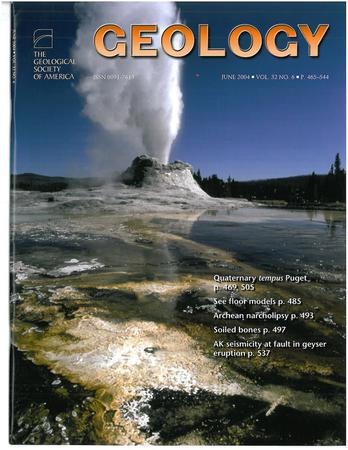The application of dual clumped isotope thermometer (Δ47 and Δ48) to the understanding of dolomite formation
IF 4.8
1区 地球科学
Q1 GEOLOGY
引用次数: 0
Abstract
Although several studies have shown the possibility of kinetic isotopic effects during the precipitation of carbonates using the dual clumped isotope proxy (Δ47 and Δ48), this approach has not yet been applied to the study of dolomite. We present Δ47 and Δ48 values of two types of Cenozoic Bahamian dolomites formed by distinctly different mechanisms. One dolomite, present in a core drilled on the island of San Salvador, is believed to have formed from normal seawater in the open system, while the other, taken from the Clino core drilled on the margin of the Great Bahama Bank, was precipitated associated with microbial sulfate reduction in the closed system. The Δ48-derived temperatures of San Salvador dolomites are consistent with their Δ47-temperatures, which are in turn close to the expected value of normal seawater. In contrast, dolomites from Clino show slightly elevated Δ47-derived temperatures (∼15 °C higher than the expected) and significantly increased Δ48-temperatures (∼145 °C) that are positively correlated with the sulfur isotopes of carbonate associated sulfate, in excess of +30‰. Such an association suggests a non-equilibrium process driven by microbial sulfate reduction, which elevates the alkalinity and depresses the pH of dolomitizing fluids. Notably, the greater amplitude of disequilibrium in Δ48 relative to Δ47 values demonstrates the sensitivity of the Δ48 proxy to kinetic isotope effects in dolomite. Conclusively, this study shows the potential of the dual clumped isotope proxy to identify microbial-mediated dolomitization in modern and ancient records.双团块同位素温度计(Δ47和Δ48)在白云岩形成认识中的应用
虽然有几项研究表明,使用双团块同位素代理(Δ47和Δ48)在碳酸盐沉淀过程中可能存在动力学同位素效应,但这种方法尚未应用于白云岩的研究。本文给出了两类新生代巴哈马白云岩的Δ47和Δ48值,它们的形成机制截然不同。在圣萨尔瓦多岛钻取的岩心中发现的一块白云石据信是在开放体系中的正常海水中形成的,而在大巴哈马海岸边缘钻取的Clino岩心中发现的另一块白云石则是在封闭体系中与微生物硫酸盐还原有关的沉淀。圣萨尔瓦多白云岩的Δ48-derived温度与它们的Δ47-temperatures温度一致,接近正常海水的期望值。相比之下,克林诺白云岩的Δ47-derived温度略微升高(比预期高~ 15℃),与碳酸盐伴生硫酸盐的硫同位素正相关的Δ48-temperatures温度显著升高(~ 145℃),超过+30‰。这种关联表明微生物硫酸盐还原驱动的非平衡过程,提高了白云化流体的碱度,降低了pH值。值得注意的是,相对于Δ47值,Δ48的不平衡振幅更大,这表明Δ48代理对白云岩中动力学同位素效应的敏感性。最后,本研究显示了双团块同位素代理识别现代和古代记录中微生物介导的白云化的潜力。
本文章由计算机程序翻译,如有差异,请以英文原文为准。
求助全文
约1分钟内获得全文
求助全文
来源期刊

Geology
地学-地质学
CiteScore
10.00
自引率
3.40%
发文量
228
审稿时长
6.2 months
期刊介绍:
Published since 1973, Geology features rapid publication of about 23 refereed short (four-page) papers each month. Articles cover all earth-science disciplines and include new investigations and provocative topics. Professional geologists and university-level students in the earth sciences use this widely read journal to keep up with scientific research trends. The online forum section facilitates author-reader dialog. Includes color and occasional large-format illustrations on oversized loose inserts.
 求助内容:
求助内容: 应助结果提醒方式:
应助结果提醒方式:


